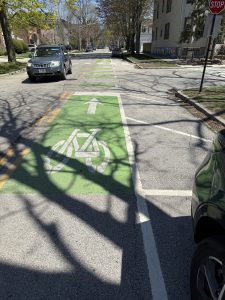Written and Reviewed by Peter Zneimer, Zneimer & Zneimer P.C.
Chicago has built over 200 miles of on-street, protected, buffered, and shared bike lanes over the last few years. Chicago has also engaged in initiatives like the Divvy bike-sharing system, which recorded over 11 million bike and scooter trips in 2024. The expansion of bike lanes in Chicago has sparked heated debates among residents, city planners, and and local businesses . The bike injury lawyers of Zneimer & Zneimer, P.C. note that protected bike lanes is the best way to keep bicyclists safe from motor vehicles. While biking advocates highlight the benefits of dedicated cycling infrastructure, some neighborhood groups express concerns about the implications for parking, traffic congestion, and seasonal usability.
Bike Lane Advantages
- Encouraging People to Ride Bikes: Bike lanes provide a safer environment for cyclists, encouraging more people to consider biking or using scooters for their daily commutes. This shift can lead to reduced traffic congestion and less pollution.
- Potential Health Benefits: Promoting cycling contributes to public health by encouraging physical activity, which can reduce the risk of chronic diseases.
- Economic Impact: Cycling infrastructure can boost local economies by increasing foot traffic to businesses and reducing transportation costs for residents.
- Affordability and Convenience: Bike lanes facilitate alternative modes of transportation for people who do not own a car in the city.
Neighborhood Opposition
- Parking Reduction: The installation of bike lanes often requires the removal of street parking, which can be a important concern in densely populated neighborhoods where parking is already limited. Small businesses can particularly be impacted by bike lanes that take away the limited parking their customers use when visiting their businesses. The parking situation in Chicago is further aggravated by the profusion of zone parking that take up the majority of parking spaces in most neighborhoods.
- Seasonal Usage: Chicago’s harsh winters can deter cycling, leading to underutilized bike lanes during colder months.
- Traffic Congestion: Some residents argue that reducing lanes for motor vehicles to accommodate bike lanes can cause can cause greater traffic congestion and slow down traffic in an already congested city.
- Safety Concerns: Some residents argue that bicyclists and scooter riders pose a safety hazard. A common complaint is that bikers and scooter riders do not follow traffic laws, such as stopping at stop signs. They also complain that scooter riders and bikers will ride on the sidewalk at times, posing a risk to pedestrians.
Dickens Greenway Bike Lane Controversy
The conflict between bike lane advocates and those opposed to bike lanes played out when a bike lane was proposed and eventually built through Lincoln Park in Chicago. The advocates argued that the bike route was needed to provide bicyclists and scooter riders access to the lake front. However, some residents opposed the bike lane. The Dickens Greenway project consists of creating a bike lane on the one way street of Dickens with a contraflow bike lane. The bike path would also run through Oz Park. The project also included crosswalks and curb extensions for pedestrian safety. The residents who support the project contend that families and children will have a way to get to Oz Park and the lake by a bike trail. However, the Oz Park Advisory Council voted to oppose the bike lane arguing that bikes and scooters riding through Oz park would be a danger for children and adults enjoying the park.
Predictably, with the surge of bicycle and scooter usage in the city of Chicago, the scooter injury lawyers of Zneimer and Zneimer P.C. have witnessed first hand the increase of bike and scooter crashes. Though it is important to create safe, protected bike lanes in the city of Chicago, the concerns of residents where these bike lanes with be placed must also be considered.
 Chicago Accident Lawyer Blog
Chicago Accident Lawyer Blog



